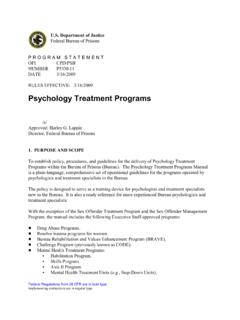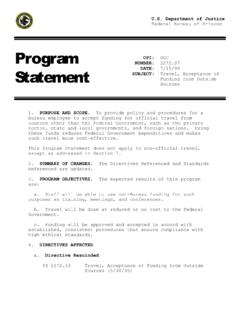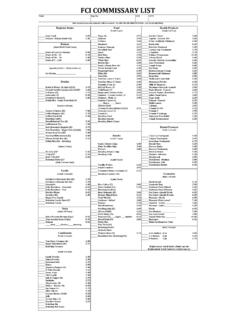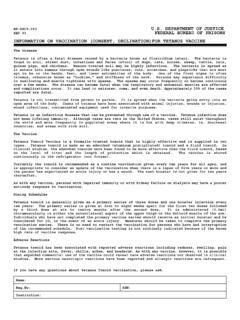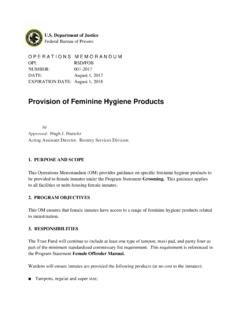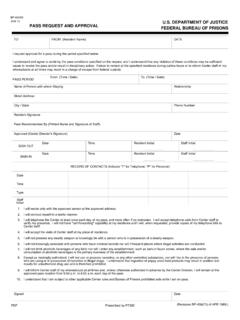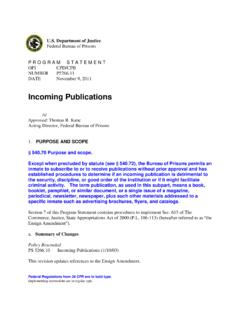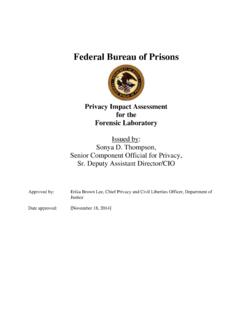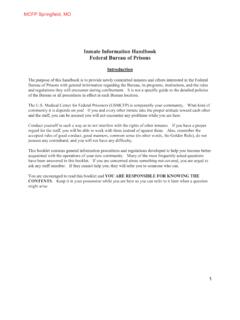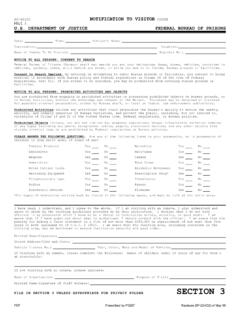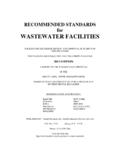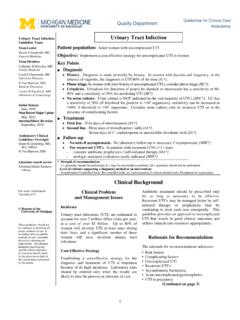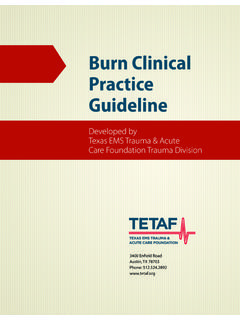Transcription of Sexually Transmitted Disease Treatment Tables
1 Sexually Transmitted Disease Treatment Tables Federal Bureau of Prisons Clinical Practice guidelines June 2011 Clinical guidelines are made available to the public for informational purposes only. The Federal Bureau of Prisons (BOP) does not warrant these guidelines for any other purpose, and assumes no responsibility for any injury or damage resulting from the reliance thereof. Proper medical practice necessitates that all cases are evaluated on an individual basis and that Treatment decisions are patient-specific. Consult the BOP Clinical Practice guidelines Web page to determine the date of the most recent update to this document: Bureau of Prisons STD Treatment Tables Clinical Practice guidelines June 2011 i What s New in This Document?
2 The following are among the changes that have been made to the November 2008 version of these guidelines , in order to be current with the Sexually Transmitted Diseases Treatment guidelines published by the CDC on December 12, 2010 (cited under References). Changes are highlighted in yellow throughout the document. Gonorrhea (see table 1): The recommended dose for ceftriaxone has been increased to 250 mg IM x1. Sex partners of patients with gonorrhea should be evaluated and treated for syphilis and HIV, in addition to N. gonorrhoeae and C. trachomatis. Chlamydia (see table 1): The BOP practice of routine intake screening for chlamydia in all females age 25 and under, regardless of risk factors, is clarified.
3 Nongonococcal Urethritis (see table 1): It is recommended that azithromycin be given DOT. Pelvic Inflammatory Disease (PID) (see table 1): The dosage for doxycycline has been changed. Abundance of WBC on saline microscopy is added as evidence to support a PID diagnosis. More conditions indicating hospitalization have been added. Herpes Simplex Virus (HSV) (see table 2): In the case of pregnancy, consultation with an obstetrician or an infectious Disease specialist is recommended. Vaginitis (see table 2): For Bacterial Vaginosis (BV), Metronidazole gel and clindamycin cream 2% have been added as possible treatments. For Candidiasis, Treatment with Clotrimazole tablets has been replaced by Treatment with one of the formulary creams: clotrimazole vaginal cream 1% or miconazole vaginal cream 2%.
4 Syphilis Primary/Secondary (see table 4): Tetracycline has been added as a Treatment for patients with a penicillin allergy. Syphilis Latent: For patients with a penicillin allergy, Treatment with doxycycline has been extended to 28 days. These patients can also be treated with tetracycline (see table 4). The criteria for case classification for latent syphilis and the clinical description of late latent syphilis have been clarified (see Attachment 1). Neurosyphilis and Syphilitic Eye Involvement (see table 4): The standard treatments now include an approach with continuous infusion of aqueous crystalline penicillin. For patients with a penicillin allergy, dosing for ceftriaxone as a possible alternative is specified.
5 Syphilis Stages and Classification This information is now contained in Attachment 1. Algorithms for Diagnostic Assessment and Management of Syndromes Seven recommended algorithms for diagnosing and managing STD-related syndromes have been posted on the BOP Clinical Practice guidelines Web page. For more information, see the References page. Federal Bureau of Prisons STD Treatment Tables Clinical Practice guidelines June 2011 ii table of Contents table 1. Gonorrhea, Chlamydia, Nongonococcal Urethritis, and PID .. 1 table 2. Herpes Simplex Virus, Vaginitis, and Genital Warts .. 2 table 3. Syphilis Screening guidelines and Diagnostic Tests .. 3 table 4. Syphilis Treatment and Monitoring.
6 4 5 Patient Educational Materials .. 5 Attachment 1. Syphilis Stages and Classification .. A1 Federal Bureau of Prisons STD Treatment Tables Clinical Practice guidelines June 2011 1 table 1. Gonorrhea, Chlamydia, Nongonococcal Urethritis, and PID Treatment (directly observed) Comments Gonorrhea (GC) (N. gonorrhoeae) of the cervix, urethra, rectum, pharynx Ceftriaxone 250 mg IM x1 Alternative treatments: Cefixime 400 mg orally x1 or Single-dose injectable cephalosporins. See CDC guidelines at: PLUS, treat for chlamydia infection unless chlamydial infection is ruled out with sensitive test nucleic acid amplification test (NAAT): Azithromycin 1 g orally x1 or Doxycycline 100 mg orally twice daily for 7 days Pharyngeal gonorrhea: Treat with ceftriaxone.
7 HIV co-infection: Treatment regimens are the same as for inmates without HIV co-infection. Pregnant women: Treat GC with ceftriaxone or cefixime; treat chlamydia with azithromycin or amoxicillin Screening: No routine screening at intake unless symptoms of gonorrhea are present, or unless syphilis or chlamydia have been diagnosed. Diagnosis: Nucleic acid amplification tests (NAAT) for symptomatic inmates. Follow-up tests to prove cure is not indicated unless symptoms persist. Contacts: Sex partners of patients with N. gonorrhoeae infections, whose last sexual contact with the patient was within 60 days before onset of symptoms or diagnosis, should be evaluated and treated for N.
8 Gonorrhoeae, C. trachomatis, syphilis, and HIV. Note: Ceftriaxone is available in 250 mg, 500mg, and 1- and 2-gram vials. Recommendation: 250 mg IM. Note: Quinolones are no longer recommended for Treatment of gonorrhea. Chlamydia (C. trachomatis) Azithromycin 1 g orally x1 or Doxycycline 100 mg orally twice daily for 7 days Alternative treatments: See CDC guidelines at: Pregnant women: Azithromycin 1 g orally x1 or Amoxicillin 500 mg orally three times daily for 7 days. Screening: Routine intake screening for females who: Are age 25 and under, regardless of risk factors, or Are older than age 25 with risk factors ( , have new or multiple sex partners) and/or Have HIV infection and/or Have history of syphilis, gonorrhea, or chlamydia Diagnosis: For symptomatic inmates, confirm infection by culture, NAAT, or other assay whenever feasible.
9 Asymptomatic infection is common in men and women. Testing for cure is not indicated following Treatment with azithromycin or doxycycline unless symptoms recur. Contacts: All sex partners in the 60 days preceding symptom onset should be evaluated and treated. Most recent sexual contact should be evaluated and treated, even if contact was >60 days before symptom onset. Nongonococcal Urethritis Azithromycin 1 g orally x1 or Doxycycline 100 mg orally twice daily for 7 days Alternative treatments: See CDC guidelines at: Diagnosis: All patients with confirmed or suspected urethritis should be tested for gonorrhea and chlamydia. Treatment : M. genitalium may respond better to azithromycin.
10 DOT dose. Contacts: Refer all sex partners within preceding 60 days for Treatment . Pelvic Inflammatory Disease (PID) Outpatient Management Recommended regimen: Ceftriaxone 250 mg IM plus Doxycycline 100 mg orally twice daily for 14 days Alternative regimen: Cefoxitin 2 g IM x 1 or other third-generation cephalosporin plus Probenecid 1 g orally x 1 plus Doxycycline 100 mg orally twice daily for 14 days Note: Both regimens can be given with or without metronidazole 500 mg orally twice daily for 14 days. Diagnosis: Minimum criteria based on pelvic exam finding: cervical motion tenderness or uterine tenderness or adnexal tenderness. The following additional evidence supports a PID diagnosis: temperature >101 F, abnormal cervical or vaginal mucopurulent discharge, elevated erythrocyte sedimentation rate, elevated C-reactive protein, laboratory documentation of cervical infection with N.
